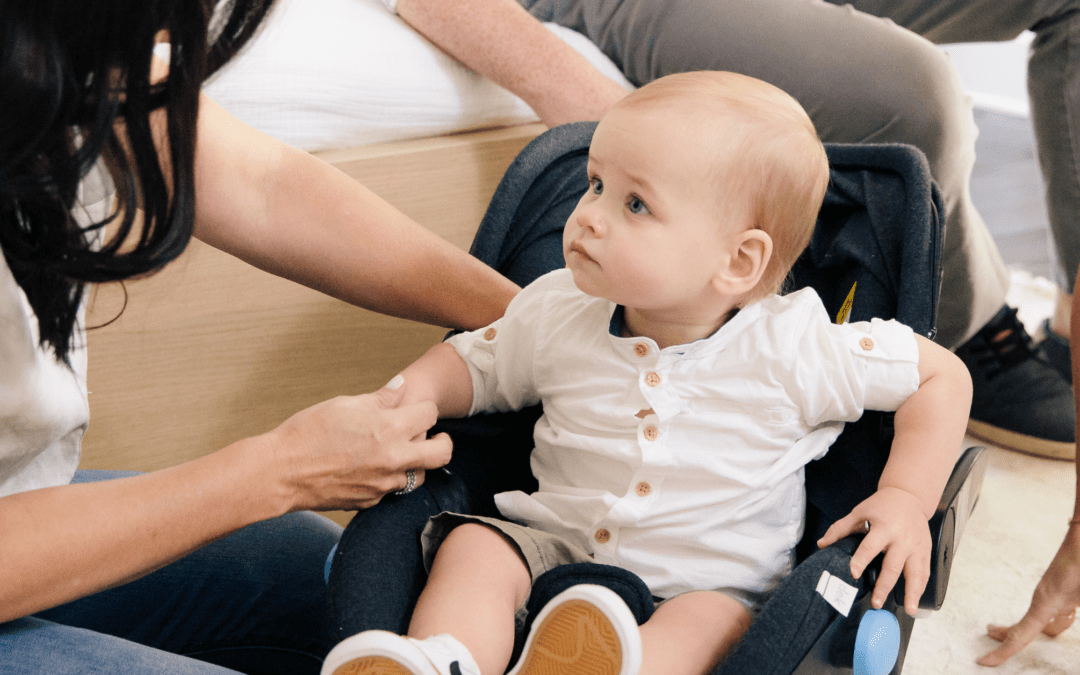There are many different types of car seats, but they’re not one size fits all. It’s incredibly important for your child’s safety to have the right seat for their age, size, and proportions. Most parents start their babies off in an infant car seat—but when should you move out of it?
Every car seat transition should be carefully considered, whether you’re graduating from the infant car seat or moving your big kid to a booster. We never want to move too early or too late! There are certain criteria your child has to meet to move up and stay safe in the seat. So, today, we’re dedicating this post to the infant car seat graduation process. Here’s when your child will be ready for a new seat:
When Is Your Baby Too Big For an Infant Car Seat
When the seat is no longer practical.
Infant car seats are known for their practicality. Unlike any other car seat type, the car seat itself can be removed from the base and towed around, which is perfect for an infant! This car seat can even attach to a stroller or wagon to make running errands and making appointments much easier.
However, sometimes, even before your child has outgrown their infant seat, the seat becomes impractical. Whether it’s the weight, the recline, or the comfort level, an infant car seat can lose its functionality as our babies grow.
As long as they are at the minimum weight for a rear-facing convertible/combination seat and the harness fit is correct, you can move out of an infant car seat. (You could even skip the stage altogether, but we don’t recommend this.)
When they reach the maximum weight.
Every car seat has a maximum weight limit. When a child reaches that maximum weight limit, it’s time for them to move up in their car seat journey. Regardless of the other points on this list! So, double-check your infant car seat weight limit. Most infant car seats have a weight limit between 30-35 lbs, but some are as low as 22 pounds.
When they reach the maximum height.
Car seat manufacturers set a weight and height limit for their car seats. For height, the maximum is usually between 30-32 inches. If your child hits either the weight or height limit, they need to move up to the next car seat stage. And most babies will reach the maximum height loooong before they’re approaching that maximum weight limit. So this is really important to keep an eye on!
When there isn’t 1 inch of clearance at the top of the car seat.
Even though the max height for an infant car seat is between 30-32 inches, children have all sorts of different proportions. If a child has more height in their torso than their legs, they may reach the top of the seat even before hitting 32 inches long.
So, as a rule, if your child has less than 1 inch of clearance between their head and the top of the car seat shell, they need to transition to a new seat. This milestone also tends to happen before baby reaches the weight limit for most babies. So watch that headspace, too!
When the car seat manufacturer specifies.
Every car seat manufacturer has different criteria for their seats. We’ve presented you with the usual infant car seat graduation requirements, but you need to consult your car seat manual to ensure there are no other specifications to watch out for. (Also, you need to double-check the weight and height maximums because they’re not all within the average we presented!)
When a Car Seat Consultant tells you it’s time.
Child passenger safety technicians (CPST) are certified in car seat safety and can give you the best wisdom on your car seat decisions. If you’re having a unique problem with your infant car seat, hire a car seat consultant online and get advice from the experts. If you have a concern that we haven’t discussed on this list, they can walk you through it and help you decide if the time has come to upgrade.
What Comes After an Infant Car Seat?
If you’ve been with us for a while, you know we recommend that your child should stay rear-facing as long as possible. This is the recommendation of all car seat safety experts, in fact! So, don’t be quick to move to a front-facing seat. Instead, transition to a rear-facing convertible or combination seat.
You can find our reviews of various convertible seats on the blog. But if you need help choosing, we also offer car seat-buying kits that make finding the perfect seat for your rear-facing child a breeze! Whatever you choose, use this handy guide for proper seat belt or LATCH installation. (It would be a good idea to do a check-in with a consultant too!)
Watch as I walk mom, Morgan, through what to look out for on her baby seat as he approaches outgrowing it and how to find the best convertible car seat for her family’s needs. This car seat will take her kiddo through years rear-facing and to car seat facing forward.
Use these tips to determine when your baby has outgrown their infant car seat.
Finding accurate car seat safety information shouldn’t be hard, but sometimes it is. When it comes to the safety and security of your infant or child, you need all the facts. This guide should help you determine exactly when it’s time to move your baby from an infant car seat to a convertible seat!
But if you need more resources, head over to the Safe in the Seat blog and Instagram! We have trusted answers to your car seat and vehicle safety questions. Finally, you can drive with peace, knowing all your kiddos are safe in their seats. Because you have the facts to make the right choices for your family. Happy driving!

